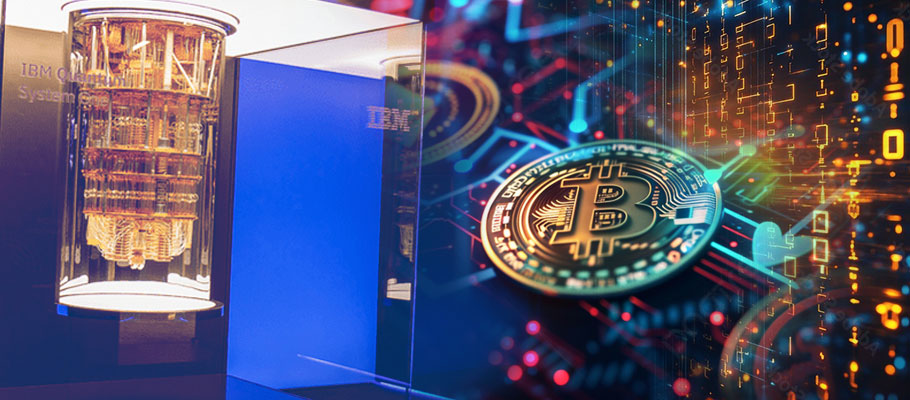
Published: June 18th, 2025
Quantum computers have been painted as a potential threat to Bitcoin on worries that their super-powered capabilities might be able to crack the blockchain's advanced cryptography. The crypto industry maintains that scenario is a long way off, but IBM has just unveiled a breakthrough that could shorten the timeline.
Called Starling, IBM's newest (though still in development) machine is a “fault-tolerant” quantum computer. Current quantum machines can calculate in multiple directions all at once, maximizing their speed and ability to process incredibly sophisticated mathematical problems. The downside is that they have high error rates.
Adding fault tolerance could give them the ability to detect and correct errors in logic as they occur, raising the possibility that they could run the complex algorithms that would be needed to break blockchain cryptography.
Set to debut in 2029, the system, called IBM Quantum Starling, is being architected to run 100 million quantum operations using 200 error-corrected qubits. The machine will operate out of IBM's specialized quantum data center in upstate New York.
“We have successfully delivered on each milestone in the 2033 quantum computing project roadmap,” IBM said in a statement. “Based on that track record we are confident that progress will continue.”
IBM's approach to quantum fault tolerance relies on super-fast error detection and correction. Because quantum systems are highly sensitive to noise and “decoherence,” the loss of data caused by environmental disturbances can disrupt processing very quickly.
IBM's fix uses Bivariate Bicycle codes, a way of parity checking code which can reduce the number of physical qubits needed to perform an operation by up to 90%.
Fears about security vulnerabilities in crypto are nothing new. As far back as 2020, cyber thieves made off with $5.4 million worth of Bitcoin, Ethereum, Tezos, XRP, Algorand, and TRON in an attack on the Eterbase crypto exchange. Criminals transferred crypto from Eterbase wallets, which Eterbase tracked to several other cryptocurrency exchanges.
Eterbase, a centralized crypto exchange based in Bratislava, Slovakia, revealed that hackers broke into its internal network and stole crypto in various coins. The incident, which was disclosed on Thursday, August 10, drained funds from the company's internet-connected hot wallets.
In a message posted on Telegram, the exchange said that the majority of the stolen funds were in the form of Ethereum (ETH), which made up about $3.9 million of the almost $5.5 million that the thieves stole.
The hackers transferred the loot to addresses in Binance, HitBTC, and Huobi, among a few other exchanges. Eterbase has since contacted the support teams of the mentioned exchanges to help recover the stolen funds.
Eterbase initiated an investigation and requested competing exchanges for their cooperation in restoring normalcy. In a message on its Telegram channel, Eterbase said it had notified exchanges where the hackers might send the stolen crypto.
The exchange rushed to put its platform on maintenance mode soon after learning of the breach and moved its home page to an all-black public service announcement saying that its hot wallets had been compromised.
The company suspended operations briefly then resumed on Friday, September 11. It was quick to reassure customers that it had adequate reserves to continue operations. And it added that it had notified the authorities of the breach.
Eterbase moved to calm users, saying that it would take every necessary step to ensure that the customers' deposits did not suffer damage due to the attack. Further investigation has focused blame on a North Korean hacking group, however the monies have never been recovered.
Hot wallets are cryptocurrency wallets connected to the internet. Their nature makes them more susceptible to unauthorized access. And, their unshielded nature is the reason why most crypto exchanges often assume the responsibility of managing them on behalf of their customers.
Almost all known crypto breaches up to that point involved funds held in hot wallets.
In September 2020, Eterbase updated the progress made in recovering the stolen crypto. In the memo, the crypto exchange shared excerpts of a crime report prepared with the help of Uppsala Security and Confirm's AML Platform.
The report indicated that Eterbase had filed a criminal complaint with Slovakia's National Criminal Agency in Bratislava. While the exchange promised to post the complaint complete with all the details on its website, it revealed the various competing crypto exchanges where the funds were transferred to and the amount transferred to each of them.
The list included 11 crypto addresses on Binance containing various crypto coins, among them Basic Attention Token (BAT), Compound (COMP), CoinSwitch (ZRX), Ether (ETH), Synthetix (SNX), Matic (MATIC), Tezos (XZT), and Algorand (ALGO).
Other details on the report include information about 16 cryptocurrency addresses on Huobi, including the amount of crypto transferred into them, and two addresses on HitBTC containing 120906.208406 BAT and 1000.000000 LINK coins, respectively.
Eterbase said it would keep track of the identified addresses and would provide updates to the data track of all stolen coins. The total value of the cryptocurrency stolen stood at USD 5,381,498.
Aside from the cryptocurrencies mentioned above, the exchange said that Ripple, Bitcoin Cash, Cosmos, Litecoin, Tron, and BitcoinSV were also stolen.
At the time, Eterbase's co-founder and CEO, Robert Auxt, said all exchanges mentioned in the report were cooperating closely with the investigations. He added that it is fortunate that the bulk of the looted assets landed inside wallets hosted by the largest providers, Binance, Huobi, and CEX.i0.
Auxt and other CEOs presented data trees to the Slovakian National Criminal Agency investigators in September 2020. He added that since the whole event fits the bill of an offense touching on criminal concerns, he expected the submissions from the exchanges to end up in the Interpol and EUROPOL offices.